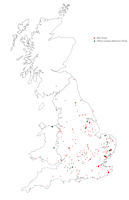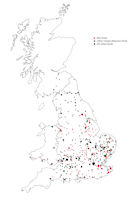

Figure 8: Distribution of metal-detector finds
Figure 9: Distribution of metal-detector and other finds
One concern about the distribution of metal figurines is the effect that reporting finds to the Portable Antiquities Scheme (PAS) may have. The scheme has not been in operation over the whole country for the same amount of time, but began with a pilot scheme in six areas (Kent, Norfolk, West Midlands, North Lincolnshire, Yorkshire, and the north-west) and was then gradually increased to cover all of England and Wales. In addition, some areas, such as Norfolk and Suffolk, already had a long history of reporting metal-detector finds to museums and the Historic Environment Record.
Figurines are not common finds on excavations, but when one compares the number of figurines found during excavation with those found by metal detectors the numbers at first seem fairly evenly matched (Table 6). Many of the figurines labelled as chance discoveries are antiquarian finds. However, it is likely that some of the chance finds, and many of those with unknown method of discovery are actually metal-detector finds. The majority of metal-detector finds have been reported to the PAS, and the remainder were mostly reported to museums or county Historic Environment Record officers prior to the inception of the scheme.
| Method of discovery | Number | % | Finds reported to the PAS |
|---|---|---|---|
| Excavation | 212 | 21 | |
| Field walking | 8 | 1 | |
| Metal detector | 275 | 27 | 190 |
| Chance | 214 | 21 | 5 |
| Unknown | 291 | 29 | 2 |
| Total | 1000 | 197 |
The distribution of metal-detector finds is shown in Figure 8, and, while it is immediately obvious that there is still a concentration in the southern band across England, the counties of Norfolk and Suffolk do show somewhat higher numbers than the surrounding areas. There are also concentrations in Wiltshire, Lincolnshire, the area around north Oxfordshire/north Buckinghamshire/Northamptonshire and a smaller group in Cheshire. The area around Hadrian's Wall is largely devoid of finds, presumably because it is now protected and not available for metal detection. Apart from access, land use (e.g. whether it is ploughed or pasture) may also affect recovery of material There are almost no metal-detector finds north of Hadrian's Wall, and fewer along the southern coast of Wales, southern and western Somerset. Interestingly, the gap between the concentrations in Norfolk, Lincolnshire and Oxfordshire/Northamptonshire is filled by excavated or chance finds (Figure 9). As might be expected, many of the urban centres such as London, Cirencester, Silchester and Wroxeter have fewer metal-detector finds, although Colchester and St Albans have produced a number of such finds.


Figure 8: Distribution of metal-detector finds
Figure 9: Distribution of metal-detector and other finds
Thus the metal-detector finds emphasise already known concentrations in certain areas of the south, but in regions such as Lincolnshire they have provided valuable new evidence where there was previously only a limited number of finds. Other areas such as Yorkshire, Lancashire, Herefordshire, Somerset, Dorset and Wales have produced little in the way of PAS finds. There are major gaps in areas where there is restricted access, such as the military sites along Hadrian's Wall and urban centres, but many of these gaps have been, and continue to be, filled by chance or excavated finds.
© Internet Archaeology/Author(s)
University of York legal statements | Terms and Conditions
| File last updated: Tue Mar 20 2012